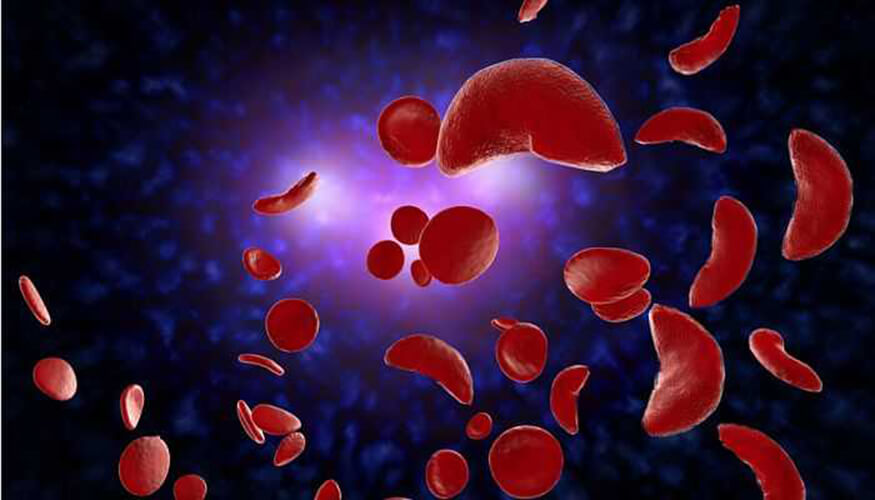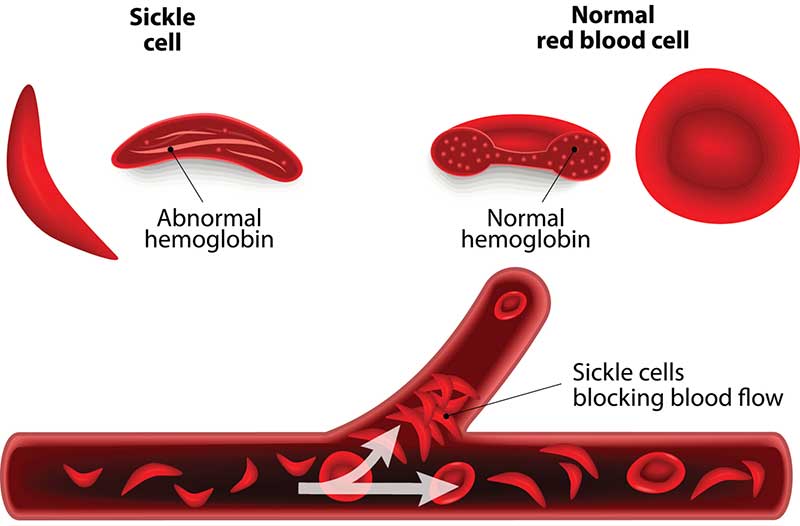Calls for Ukraine
Calls for Europe
Calls for USA

Sickle cell anemia is a hereditary pathology, the peculiarity of which is the abnormal structure of the blood protein hemoglobin. Red blood cells with such hemoglobin have an irregular crescent shape, cannot fully perform their functions and often clog small vessels. As a result, a person can develop a whole range of pathological conditions. Chronic anemia, pain crises often occur, the likelihood of tissue ischemia, diseases of the heart, kidneys and other organs increases.

Sickle cell anemia is caused by a gene mutation that produces defective hemoglobin. Hemoglobin is a protein found in red blood cells and is responsible for carrying oxygen to body tissues. Normal red blood cells are quite flexible and have a rounded shape, due to which they easily move through the vessels and deliver oxygen throughout the body. Red blood cells in sickle cell anemia with altered hemoglobin look like a crescent. They are tougher, break easily and have a much shorter lifespan. In addition, they often stick to the walls of blood vessels, stick together and block the lumen.
Sickle cell anemia occurs in those who inherit a gene with a particular mutation from both their mother and father. Then they talk about homozygous sickle cell anemia. If a person has only one altered gene, this is a heterozygous form. In this case, the patient is a carrier, but the disease develops only in rare cases under certain conditions.
The characteristic symptoms of the disease include:
This pathology leads to a number of dangerous complications. Due to the fact that the probability of blockage of blood vessels is increased, there is often a violation of the blood circulation of various organs: lungs, heart, kidneys, liver, spleen. The most common complications of sickle cell anemia include lung failure, chronic kidney disease, and heart failure. Strokes can develop, not only in adults, but also in children.
The work of the immune system worsens, which leads to the frequent development of infectious diseases (including meningitis, pneumonia and other dangerous diseases). In severe cases, complications can lead to death.
This disease significantly reduces life expectancy. Usually after 10 years the quality of life noticeably worsens and complications develop. Quite often, people with sickle cell anemia die in childhood.
According to statistics, today the average life expectancy with this diagnosis is 50 years. But there is a constant search for methods of treatment that will effectively deal with this pathology.

Sickle cell anemia in humans is diagnosed through laboratory blood tests. Changed red blood cells can be seen under a microscope. But in order to accurately determine the form of the disease, hemoglobin electrophoresis is additionally done.
Additional examinations may also be prescribed, depending on which organs have suffered from a lack of oxygen.
In order to determine whether a pathology is present in the fetus, a special prenatal diagnosis is made during a woman’s pregnancy.
The disease requires lifelong treatment and is difficult to treat. The goal of traditional treatment is to avoid crises, reduce symptoms and improve the patient’s quality of life. To this end, the doctor may prescribe anticoagulants, painkillers, anti-inflammatory drugs, dehydration therapy, oxygen therapy. In severe cases, a red blood cell transfusion may be performed.
Such treatment does not lead to recovery, but gives a temporary relieving effect. However, today new methods are emerging that allow reaching a new level of the fight against the disease.

The only treatment for sickle cell anemia that can lead to a complete recovery is the use of stem cells. Stem cells have a unique feature – they can turn into different types of cells, including blood cells. Cell therapy involves the transplantation of such cells from a donor to a patient.
Usually, close relatives (brother, sister, parents) who do not have this disease and at the same time have compatibility according to certain medical indicators act as a donor. Also, a person with whom there is bone marrow compatibility, but no family ties, can act as a donor.
Basically, this technique is recommended for children and young people, but in the future its use for older people.
If the therapy is successful, then transplanted cells from the donor’s bone marrow replace the patient’s bone marrow. The body begins to produce normal red blood cells, the immune system is restored, the symptoms of the disease go away even in severe forms.
To learn more about stem cell treatment, contact us! The medical coordinator of MedTour will consult on all your questions.
You can get to the leading specialists in the treatment of sickle cell anemia, find the best doctors in different countries of the world. MedTour company will help you find a clinic and a doctor, and will take care of organizational issues.
You can get advice on stem cell treatment from Dr. Andrey Kovalchuk, surgeon, PhD, specialist in regenerative medicine. It is possible to sign up for an online consultation with Dr. Kovalchuk!
Please rate the work of MedTour
